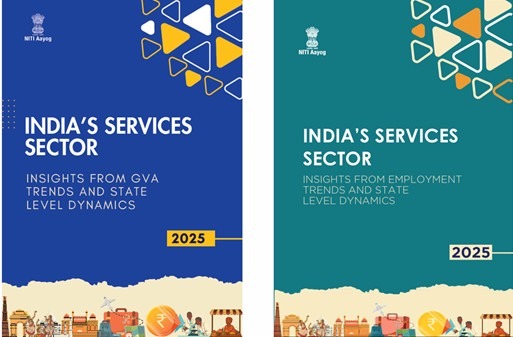
NITI Aayog has released two inaugural reports under its Services Thematic Series, offering a comprehensive and disaggregated assessment of India’s vital services sector. The reports, launched by CEO Shri B.V.R. Subrahmanyam, examine the sector through the crucial lenses of Gross Value Added (GVA) and employment trends. They provide state-level insights beyond aggregate national figures.
The services sector has cemented its position as the engine of India’s economic expansion. It contributes nearly 55 per cent of the national GVA in 2024–25.
Insights from the GVA Trends Report
The first report is “India’s Services Sector: Insights from GVA Trends and State-Level Dynamics.” It reveals that services-led growth is becoming increasingly broad-based and regionally balanced. Despite a modest widening of inter-state disparities, the report finds clear evidence of structurally lagging states beginning to narrow the gap with more service-advanced regions. This convergence suggests that the services transformation is becoming spatially inclusive.
To accelerate diversification and global competitiveness, the report recommends prioritising digital infrastructure, logistics, innovation, finance, and specialised skilling programs. At the state level, the key recommendation is to develop tailored service strategies based on local strengths, improve institutional capacity, and scale up urban and regional service clusters in Tier-2 and Tier-3 cities.
Employment Challenges and the Way Forward
The companion report is “India’s Services Sector: Insights from Employment Trends and State-Level Dynamics.” The report analyses the multi-dimensional profile of the services workforce. It highlights a dual character within the sector: modern, high-productivity segments that are globally competitive but limited in employment intensity, and traditional segments that absorb large numbers of workers but remain predominantly informal and low-paying.
The analysis shows that while services are central to employment growth and post-pandemic recovery, challenges such as uneven employment generation and widespread informality persist. The report notes significant gender gaps, rural–urban divides, and regional disparities that must be addressed to ensure inclusive growth.
Policy Roadmap for Viksit Bharat
To bridge these gaps, the report outlines a robust four-part policy roadmap. This strategy focuses on:
- Formalisation and social protection for gig workers, the self-employed, and MSME workers.
- Targeted skilling and digital access to expand opportunities, particularly for women and rural youth.
- Investment in emerging and green economy skills.
- Balanced regional development achieved through the establishment of service hubs across Tier-2 and Tier-3 cities.
By implementing this roadmap, NITI Aayog emphasises the sector’s pivotal role in achieving the vision of Viksit Bharat @ 2047 (learn more about the core goals of Viksit Bharat). These reports offer a pathway for state governments and industry to unlock the next wave of services-led growth. The aim is go position India as a trusted global leader in services.
You can read the full NITI Aayog’s reports detailing India’s services sector at:
https://niti.gov.in/sites/default/files/2025-10/Indias_Services_Sector_Insights_from_GVA_Trends_State_level_Dynamics.pdf and https://niti.gov.in/sites/default/files/2025-10/Indias_Services_Sector_Insights_from_Employment_Trends_State_level_Dynamics.pdf





